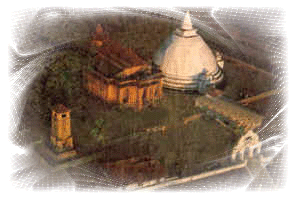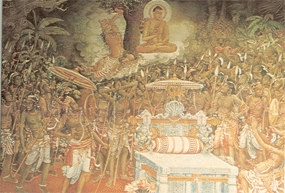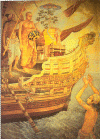|
|
|


Situated about six miles from Colombo, set within a sacred area of around ten acres, the Kelani Vihara stands beside the Kelani river as evidence of a Buddhist tradition in this country.
The spot on
which this vihara stands derived its sanctity in the Buddhist era 2531, with the
third visit of the Buddha to this country. He hallowed this ground by His visit
accompanied by 500 Arahants. The fact that the Buddha visited the spot on a
Wesak day on the invitation of King Maniakkhika is given in the historic epics
of Sri Lanka.
 The Naga King, according to these chronicles
had invited the Buddha to a repast at this spot which following the expounding
of the Dhamma was consecrated and on which the King had built a vehera wherein
the Buddha's hair and the utensils use at the repast together with the seat on
which the Buddha sat were buried.
The Naga King, according to these chronicles
had invited the Buddha to a repast at this spot which following the expounding
of the Dhamma was consecrated and on which the King had built a vehera wherein
the Buddha's hair and the utensils use at the repast together with the seat on
which the Buddha sat were buried.
However with the advent of time and the destruction of the vihara by the foreign
invaders has resulted in the original dageba being lost today.
Kaleniya
Vihara however, received its hallowed status and became a place of Buddhist
worship after venerable Mahinda brought the Dhamma to this country.
Historical evidence shows that the Kelaniya Vihara was at its highest glory during the Kotte Era. By the time the Portuguese conquered the country considerable land had been donated by the kings to the Kelaniya Vihara, and when in 1505 the Portuguese entered and took over the area, they had confiscated this land preventing Buddhists from worshiping at the temple.
Restrictions
placed on the development of Kelaniya were reduced with the advent of the Dutch.
They in 1780 perhaps in order to gain King Kirthi Sri Rajasingha's good will
permitted him to develop Kelaniya Vihara. Thus the reconstruction of the Vihara
was undertaken by the then Chief incumbent Venerable Mapitigama Buddharakkhita.
he was provided with funds from the treasury. The King was so overjoyed at the
way the work was handled that further grants of lands had been given to the
vihara.
The next regeneration of the Kelaniya vihara came when Mrs Helena Wijewardana
took over the task of renovation. She was aided by the then Viharadhipathi
venerable Mapitigama Dharmaarakkhita thera. At this stage the ancient murals
paintings and sculpture had begun to deteriorate. Mrs Wijewardana was able to
get the services of one of the greatest painters of the Era to do the
renovation.
 Solius Mendis the painter brought the ancient paintings to it's original glory
by using paints that he him self had made from organic matter available. The
renovation work took 20 years to complete.
Solius Mendis the painter brought the ancient paintings to it's original glory
by using paints that he him self had made from organic matter available. The
renovation work took 20 years to complete.